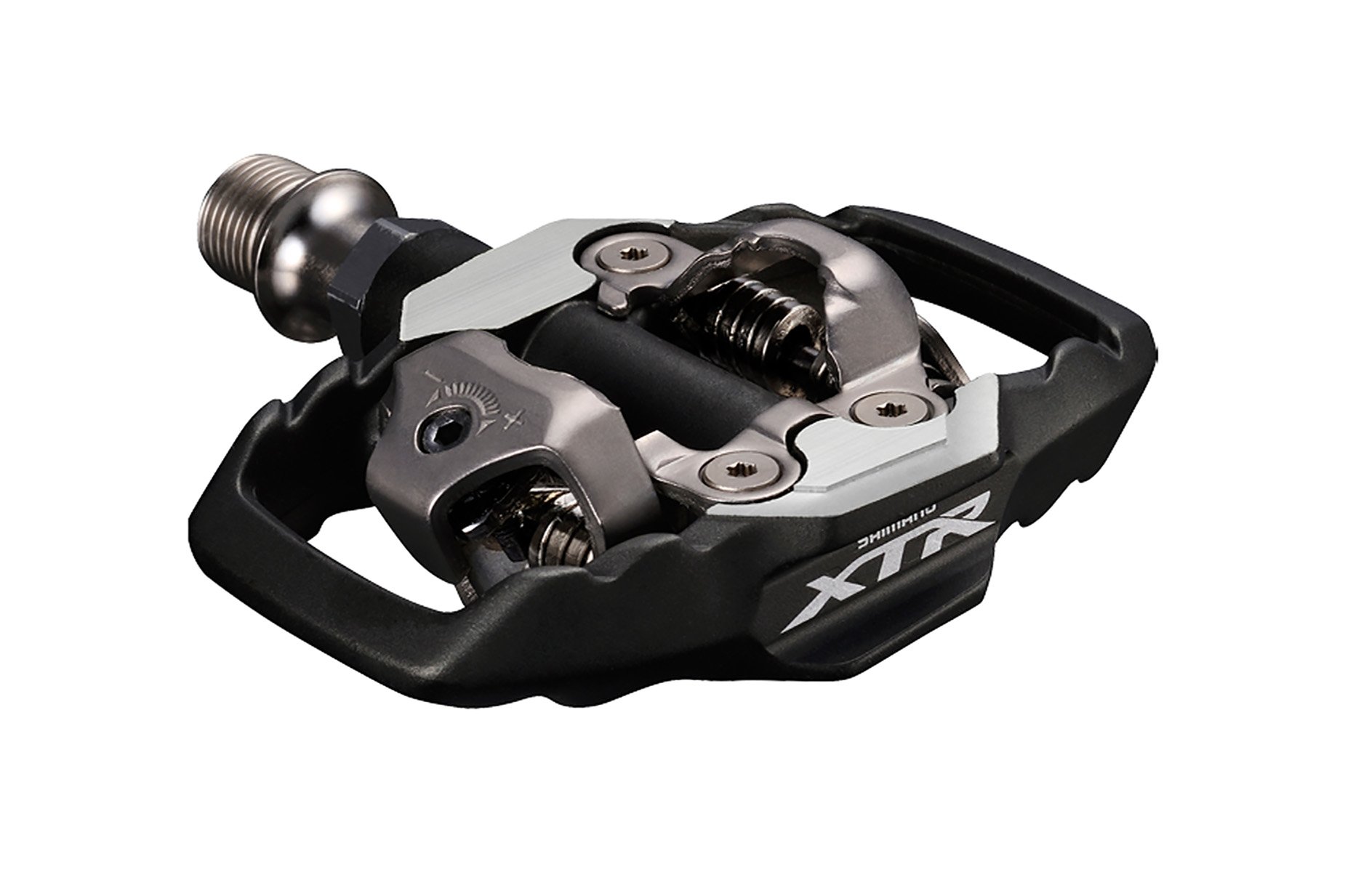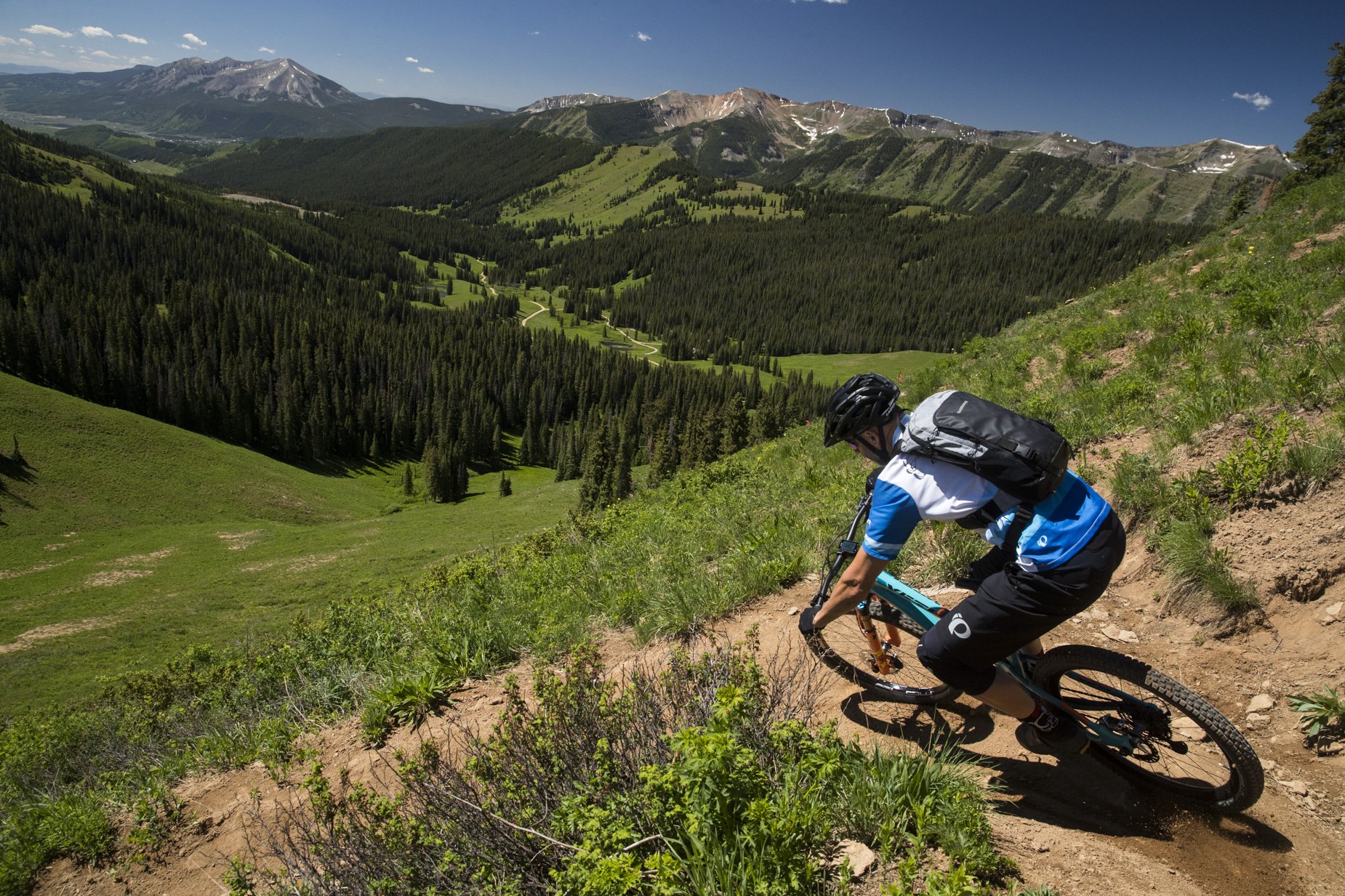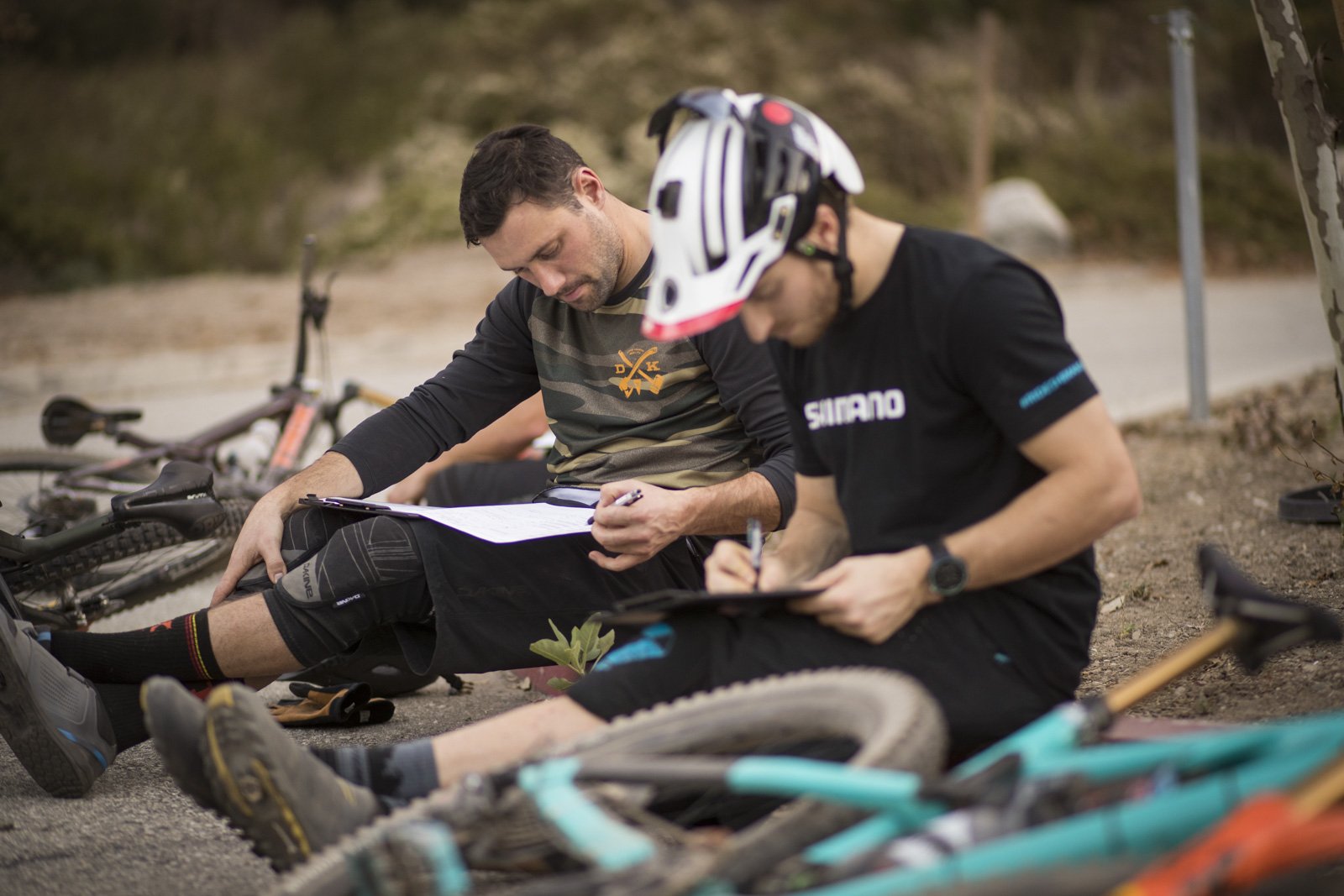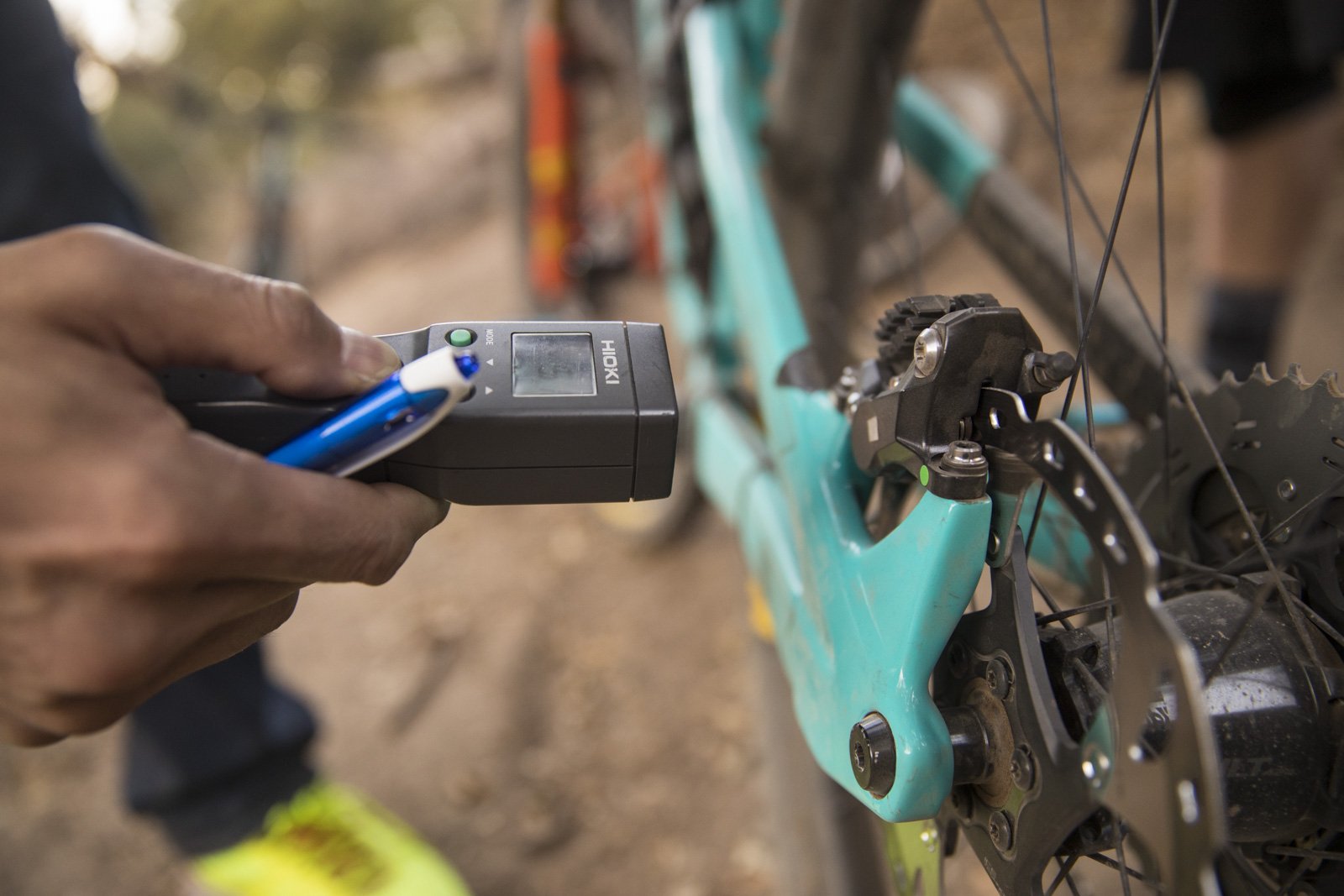
First Rides Review
Riding 2019 Shimano XTR 12spd in Crested Butte
More words have likely been spilled about the pitfalls of gear obsession than any other topic in mountain biking.* Words like purity, heart and soul dominate these pieces; it should be about the ride damnit, not about the dongles and bits that help propel us.
*from the publications I have cared about over the years at least

Thomas Vanderham captured testing XTR brake prototypes in late 2016.
It's a solid thesis. Riding bikes takes us to some mind blowing locations, places we wouldn't otherwise see. And you don't have to be a hippie to notice that even rides without holy-shit views can nourish something within us, as long as we escape the urban and commercial and pay attention some. If our competitive nature has us obsess about weight, anodizing, weirdness, or exclusivity, all to 'win' the gear game, we aren't likely to notice or absorb the benefits mama nature can deliver.

There was no shortage of soul-nourishing natural radness in Crested Butte. And Sterling Lorence captured it expertly.
Like most well-worn themes, this one can be turned inside out. You aren't likely to hear the wind in the birches if your cranks creak like a squashed toad and you won't notice that once-in-a-lifetime view while freeing a chain jammed between cassette and spokes. If your brakes are inconsistent or powerless you'll be too terrified to appreciate the brilliant undulations and curves of the trail ahead - or to get speed for that double and enjoy a moment without weight. Minor issues can detract as well; a dropper remote you can't reach, a derailleur that fails to mount your largest cog, or even the high pitched buzz some freehubs emit.
Note - for details on new XTR click here. To learn about the factory where XTR is made click here.

Shimano's Joe Lawwill enjoying a moment without weight in Crested Butte's Evolution Bike Park.
The moments of pure bliss, of magic on dirt, rarely occur when our gear sucks, whether it is inferior, poorly maintained or broken. The bike can't disappear beneath you when the harsh bottom-out of your clapped out fork jolts you violently. This isn't a meditation on dropping cash; bikes both complex and simple, expensive and cheap, can be transcendent, but increased complexity brings more opportunities for failure and frustration.
In our XTR presentation in Osaka, the theme was race; that is, we were told, what the R in XTR stands for. In Colorado, at least during my session there last week, we were not racing. In our short presentation it was noted several times that the ergonomics and function of this incarnation of Shimano's top group were meant to be intuitive; the dropper remote should feel natural immediately, the upshifts shouldn't clunk and the freehub should be entirely silent and drag free. When some complex function occurs without you noticing, like your brakes performing consistently top to bottom on a long, steep mid-summer descent, the engineers have nailed it.

Most out of the park riding was sweet mellow and smooth, but techgnar was available in the Evolution Bike Park.
I knew we were riding at elevation, and my trip to Peru taught me a little about what that means, but this trip involved no acclimation; the morning after we arrived we saddled up and started to climb from our hotel at 9300' (2835m). I was on an Intense Sniper XC; 100mm of travel and (I think) 120mm up front from a Fox 34 Stepcast. It had skinny Vittoria tires and that sucker was light. We were given a list of bikes to choose from long before the trip and this bike was not on my list. I was grateful for it as I struggled on the climb but much less so through sharp rocks on the descent.

In these images multiple clamps hold shifter and lever to bar, but the samples we were shown in Japan were attached using I-Spec employing a single clamp. The braced lever was noticeably stiffer and more responsive than others I have used.

The rubberized surface of the thumb lever, which adds extra friction and control, is replaceable. Shifting was incredibly light and smooth. Shimano studied how riders moved from bar to lever and tried to remove any wasted motion. Rather than hitting the end of the lever the idea is to hit the meat of the lever. The focus was having more natural thumb movement rather than having to push straight forward in a line.
The cockpit was extremely easy to set up. There is lots of rotation and fore and aft available for both the shifter and dropper remote and finding my sweet spot was a snap. The bike initially had XC pedals but the Shimano techs happily switched to new XTR trails for me (thanks lads!). I was more curious about Hyper Glide Plus, Shimano's ramped-cog system, employed in the opposite direction for the first time (check my article from the product presentation in Japan for a deep dive on this). Normally shifting to a higher gear (smaller cog) produces a reassuring clunk. Thanks to gravity, these shifts require the least effort but chain and cog lose contact for a moment, during which time no power can be generated and the chain drops abruptly. Shimano has been trying for years to steer the chain toward ramps for these shifts to have no interruption in power but it's been elusive until now.

This Intense Sniper wasn't a bike I would have chosen, but it did the job well enough. On the climb at least.

10-51 came in very handy in the thin air around Crested Butte.
In the parking lot this was easily felt. For some changes it feels like there is a momentary shift delay, but Shimano tells us this system actually reduces the time it takes to shift and allows you to keep the power down without getting a jolt. Apparently, the faster you are going the more effective HG+ is. I didn't have many high speed upshifts on our trail and bike park rides but those I had were mostly silky. Occasionally I'd get the traditional clunk because shifts won't always align with ramps - but I'd say most shifts were ramped.

Shifting smoothness and precision were second to none. Most of the lighter action comes from a new clutch design. The new derailleur reduces excess chain motion improving retention.
Going the other way, shifting to a lower gear (larger cog), has been improved as well. The lever action was exceptionally light without being indistinct. Shimano has also changed the feel of a two click shift; pushing the thumb lever to a first and then second detente which moves the chain two cogs up the cassette. In the past the first click had the same feel as the second but now the second click has a little more resistance, making it more difficult to do accidentally. If I hadn't been told this I likely wouldn't have noticed, but it's the sort of thing your body adjusts to even if your mind fails to register. The shifting was the sort of Shimano silky many riders have come to love, and certainly the smoothest of any 1x wide-range cassette I have ridden. Smooth shifting, very low chain noise, everything was feeling great.

You wouldn't be the first person to think that XTR trail pedals have always been designed to provide support around the cage, but that isn't the case. Only the silver surfaces actually make contact with the bottom of your shoe.

The new pedals take greater advantage of the cage and do a much better job of supporting your foot. The entire rear portion of the cage pushes into your shoe. Shimano tells us the new design performs better in muddy conditions and is designed to be tolerant of mud build up. If you have to walk through the mud the pedal should work to clear that.
Another thing I noticed right away is the new XTR enduro pedals. I never understood why the cages around these pedals didn't offer more support. This seemed like a missed opportunity. Shimano told us the idea was to add some security only when you were unable to clip in, however meagre it might be. If you look at the contact area between shoe and pedal and compare an XTR trail and an XTR XC pedal of the current generation, there isn't much difference. Now the area behind the mechanism rises to contact the bottom of your shoe, providing a very stable and secure connection, both side to side and when digging your heels in. Clicking in and out was distinct and predictable as expected.
The holy trifecta of power, modulation and consistency seems to have been achieved.

The Alchemy Arktos was a worthy companion at altitude.
After our morning climb we got a chance to check out the Evolution bike Park and I saddled up an Alchemy Arktos 27.5 for the rest of the trip. Photos with Sterling Lorence were on the agenda and we tipped right into Avery and then Boulder Mason, a steep and rocky black diamond trail. Everything felt fine but our steep early trail choice left the brakes howling like a mofo. The pads and rotors didn't get the more gentle bedding in that leads to silent operation, which meant any realistic brake evaluation was out.

Who doesn't like a good rock garden? I believe this was the end of Boulder Mason.
The 804 - Elevation and Braking
Many trails in Colorado are named like highways for some reason, and our second day adventure was to complete the 401 and 403 together, which makes for an 804 apparently. These names are as boring as taxes, but at least builders won't be chastised for being politically incorrect. We got a shuttle up to where the 403 singletrack began and crept to the summit at 3475m (11,400'). The descent is rated black diamond but I'm not sure why. Aside from a few rocks, the trail was fun but not terribly challenging. I was anxious to see how the brakes would fare with properly bedded in pads and rotors and I was not disappointed.

Based on an admittedly small test sample, the XTR enduro brakes were among the best I have ever used. Finned or non-finned can be used and the enduro brakes will have metallic pads while XC get resin. Metallic pads bite earlier, resist contamination better and deal with mud without wearing prematurely. Saint pads fit perfectly as well.
After the 403 we took a little break, got another shuttle bump and then began the more serious climb up to the 401. I wasn't very peppy on the singletrack climb but I made it to the top and was rewarded with a fun and swoopy descent with lots of speed and supportive corners thanks to recent rain. This was riding of the superhero variety. Areas of shoulder-deep skunk cabbage made finding the trail more interesting, with lots of last second decisions and guesses. It looked soft to fall into at least. On this second descent we did a long uninterrupted segment and I was eager to see if the new XTR enduro brakes would fade or pump out with the heat, but there was no discernible change of engagement point or power all the way to the bottom. The braced lever provides a very solid and precise feel and power was ample and impressively controllable. The holy trifecta of power, modulation and consistency seem to have been achieved.

Dropping a shoulder into the endless ribbon.

Joe Lawwill is an accomplished racer and the man rips. He even survived B.C. Bike Race as Brian Lopes' Partner.

The beginning of a descent is particularly sweet above 11,000 feet.
The lever has changed slightly in width and it's welcome. The slightly larger flat surface that greets your finger is comfortable and effective. Apparently racers wanted a lever that would be more likely to survive a crash which meant no carbon. For me, the only advantage of a carbon lever is that it sucks less warmth from your finger in the winter, which is a significant factor for those of us who ride all year round.
The Remote will feel like an old pair of shoes really quickly. - Nick Murdick

Good looking, silent and relatively fast engaging; Scylence Hubs are a highlight of the group.
Scylence
The new hub design, that decouples completely when freewheeling rather than using pawls, is brilliant in action. Apparently this feature allows Jesse Melamed to hear how much adhesion his tires have left. I can't say my perception was similarly advanced, but the absence of noise is glorious. Lately I've been riding a loud hub and I actually enjoy the way the whine reflects my velocity, but given the choice I'd rather be silent but deadly, like a ninja.

While Shimano has always used rider feedback, this time around elite athletes were involved earlier in the process so real changes could be made based on their observations. Here Andrew Shandro does some light brake testing.

Thomas Vanderham (left) and Jesse Melamed writing brake test final exams.

Measuring rotor temperature during the test sessions. Temp = hot.

Some brakes are more effective in the air than others. Jesse Melamed works to slow gravity.
The Process
Until this iteration of XTR, Shimano has acted a little like Apple; they knew more about what we wanted than we did. An obvious example of this going wrong was dual control, but there were problems more recently as well and apparently many racers had problems with the last version of the group. It took a big push from North American staff to alter that process. In the past, by the time racers and other product testers were seriously involved in product development, it was too late to make meaningful changes. This is one reason why SRAM managed to gain such a big advantage in such a short period of time.

While many are going crazy for Titanium, IMHO these are the most beautiful cranks of the current generation. My Arktos did not have the new XTR chain guide installed.
Clearly it was time to scrap that thinking and get skunk riders and racers involved. Part of this process involved establishing a clear sense of what riders wanted, which led to the poll mentioned in my earlier article. To recap briefly, Shimano asked what their top 150-200 elite athletes wanted, particularly for drivetrain. The final products (both 11 and 12spd options, Rhythm Step and wide range) were a direct result of this consultation.

“The Remote will feel like an old pair of shoes really quickly.” - Nick Murdick. Rather than having to figure out the "secret handshake," the new dropper remote tries to replicate the release lever of a shifter. Is also apparently more out of the way than most others.
To get the enduro brakes dialled in, Shimano called on the all-Canadian squad of Thomas Vanderham, Andrew Shandro and Jesse Melamed for testing in October 2016. Four different designs were presented, the goal being Saint power in a more controllable fashion. Different sized pistons were tried and shorter lever throw was used. Eventually a different tune was arrived at, emphasizing modulation without compromising power, with the final tweaks coming from the Servo Wave curve. The main point is that after a multitude of runs on these four different brakes, Vanderham, Shandro and Melamed were able to provide feedback that led to significant changes. In the past, by the time this sort of thing happened, only minor tweaks were possible.

e*thirteen, Raceface, ENVE and Stan's will all be selling aftermarket wheels with Shimano Scylence Hubs. Eventually...
What's Not to Like?
Some questions remain of course. We do have pricing info now and some weights but availability remains a question mark The group on its own will cost 2160 USD, which can buy you a decent complete bike. But an XX1 Eagle drivetrain alone will set you back 1475 USD, while an XTR drivetrain MSRP is 1385 USD. You'll need hubs of course, or at the very least a driver for DT hubs, but the pricing And what about trickle down? SRAM has already pushed Eagle two and a half steps down so that NX is now available. It's likely that Shimano is working on an XT version of this new 1x system and maybe even SLX, but when they'll arrive is anyone's guess.

Thomas Vanderham following Andrew Shandro to see who can slow down best.
While Shimano may be late to the party of wide range 1x, it seems that polling and listening to racers, exhaustive testing, and of course Shimano's engineering prowess, has produced a group that is difficult to fault. Based on our riding in Colorado, the brakes are exceptional, shifting is incredibly smooth and precise, and the silent hub lets you hear mosquitoes chewing on your neck. The small details, like the dropper remote, pedal tweaks, and chain modifications, are also well thought out and executed. These seem to be the sort of components that can disappear beneath you, allowing the pure transcendent experience of perfect single track to nourish our souls and cause our hearts to break into song. Likely some Rick Astley.
But most of all 2019 XTR will make our buddies jealous of our beautiful componentry so we can win the gear game.







Comments
Nouseforaname
5 years, 10 months ago
If SRAM listens to it's racers and athletes so much, how come there's only one size for an Eagle cassette - XC or Enduro regardless?
Shimano - XT version of this that drops the 10t cog and fits a standard freehub please. Don't make me beg.
Reply
Cam McRae
5 years, 10 months ago
I don't have much knowledge about how much SRAM consults athletes.
Your 11-51 is an interesting idea that, based on the way Shimano develops products, is unlikely to occur.
Reply
Jason Wolfe
5 years, 10 months ago
An 11-51 on standard shimano freehub is precisely what many of us want, and it just makes good sense. I’m willing to beg.
Reply
ZigaK
5 years, 9 months ago
I would like this new sylence hub with the old freehub interface.
Let's say next year with the new xt.
Reply
Nouseforaname
5 years, 10 months ago
@cam - Until this iteration of XTR, Shimano has acted a little like Apple; they knew more about what we wanted than we did. An obvious example of this going wrong was dual control, but there were problems more recently as well and apparently many racers had problems with the last version of the group. It took a big push from North American staff to alter that process. In the past, by the time racers and other product testers were seriously involved in product development, it was too late to make meaningful changes. This is one reason why SRAM managed to gain such a big advantage in such a short period of time.
Read to me like - SRAM listens to it's athletes rather than telling them what they can have (unlike old Shimano) and that's why they have gained such a big advantage in such a short period of time. :shrugs:
Reply
Cam McRae
5 years, 9 months ago
What I was told is that Shimano wasn't listening to athletes - or product staff outside of Japan apparently - until late into the product development cycle until quite recently. SRAM development doesn't happen in a vacuum in the same way from what I understand. There are many staff, and presumably athletes (although I don't have specific info about this), involved and it seems to be very much a collaborative effort. Whether athletes are the difference, I couldn't say.
Reply
Alex D
5 years, 9 months ago
Much of the appeal of this group is the silent hub. Problem is, it's chained to the rest of the group. Micro Spline implies the XTR cassette. The 11S and 12S models use the same spacing, which is different than current 11S. I assume they didn't adopt SRAM's 12S spacing, so that means buying the XTR shifter and derailleur as well. The whole thing gets mega-expensive very fast.
How'd you feel about the hub engagement? It's akin to roughly 50 POE, right?
Reply
Nouseforaname
5 years, 9 months ago
Really - the silent hub? That's the appeal? Proof that everyone's different I guess.
The appeal to me is that if XTR 12 is here in the Fall, XT (and maybe SLX) 12 will be here about 12 months after that - and I won't be locked into over priced SRAM cassettes and derailleurs.
Reply
Alex D
5 years, 9 months ago
This comment has been removed.
Cam McRae
5 years, 9 months ago
I'm afraid I'm not fussy about engagement, but it was fine for me. Never once have I pedalled a properly functioning bike and decided there weren't enough points. We were told it measures 7.6º.
Reply
der_hasi
5 years, 10 months ago
"We haven't received pricing info, weights have been tough to come by, and even availability is an unknown at this point."
You are welcome: https://r2-bike.com/SHIMANO-XTR-complete-Group-M9100-1x12
Reply
Cam McRae
5 years, 10 months ago
Well thanks - but considering there are only 25 groups in existence right now - there seems to be a lot of speculation there. Perhaps that info is legit, but it's just as easily based on rumours and guesses.
Reply
der_hasi
5 years, 9 months ago
I guess you are right :(
Reply
Cam McRae
5 years, 9 months ago
I found the pricing (and some weights). It arrived at the 11th hour before I posted the previous piece (and I forgot!). So those numbers could be accurate!
Reply
hongeorge
5 years, 10 months ago
Any idea if the Shimano mech works with the Eagle cassette?
I hope it does, there's no way I'd go to the hassle of a new freehub to end up with a cassette with all those alu cogs. It's just too soft a material to make cassettes out of
Reply
Cam McRae
5 years, 10 months ago
"All those aluminum cogs?"
Only the three largest are aluminum. More info here https://nsmb.com/articles/2019-shimano-xtr-9100-10-51-12spd-here/
Reply
hongeorge
5 years, 10 months ago
That's three too many for me - I've been down that road before, and the teeth only lasted weeks. Plus I'm fully bought into XD drivers on all my wheels at this point, so I've got no great desire to move back to Shimano cassettes anyhow.
Had great luck with SRAM XD cassettes thus far, really impressed with the durabilitty. Happily running them with Shimano 11 speed mechs/shifters.
Reply
slyfink
5 years, 9 months ago
I totally agree that the SRAM X-Dome cassettes are remarkable for their weight and durability, and work super-well with Shimano derailleurs and shifters.
I'm still running a King hub in 142x12. When the day comes that the hub cannot be transferred over to a new frame, I hope this Scylence system is broadly available. The main reason I moved to a King hub was to get away from pawls. I would blow up hubs with pawls on a regular basis, so wanted something more robust. King's quality is undeniable, but the value for money proposition has just changed (imo) with this design.
I really prefer Shimano's silky action vs. SRAM's positive "clunk", so if this new gruppo improves on that, and addresses the pitfalls of pawls, then they've addressed two of my biggest concerns. As long as the weight of the system remains comparably low (it is unsprung weight after all), I'll be down with the blue.
When the time comes of course, since for now, my King hubs, XO cassette, XT derailleur, XTR shifter of my Transition Patrol are likely to carry me for another few years. I hope.
Reply
Merwinn
5 years, 9 months ago
Oh it might 'operate', but work well? I seriously doubt it. These days, once you pick a side, they lock you in.
Reply
hongeorge
5 years, 9 months ago
SRAM 11s cassettes with Shimano shifting works brilliantly - and without the backpedalling issues that you get with Shimano cassettes (not to mention the extra weight) Current XTR Mech/Shifter with X01 cassette is the most reliable shifting I've ever had...
Reply
Endur-Bro
5 years, 9 months ago
I take it this XTR free hub is based on the patent they filed a few years back. Besides DT will others be able to use the free hub body design?
I find zero issues with the group set. If the dropper lever is priced below WTC version it should do well. XTR cranks are some of the best looking cranks in production. Would be interested in the brakes but I'm starting to debate leaving Shimano brakes for others.
Reply
Nouseforaname
5 years, 9 months ago
That's the big sticking point - right now (but not for too long hopefully) only DT and Shimano can use the freehub design. I don't know how effectively they can police that, but i'm hoping for wider spread adoption. I'll not be buying Shimano or DT hubs any time soon. Hopefully OE pressure changes that...
Reply
Cam McRae
5 years, 9 months ago
We were told that only DT is allowed to use the Micro Spline design.
Reply
Nouseforaname
5 years, 9 months ago
I wonder how robust the patent is? How many splines are needed - can I make a freehub body with only four splines because the patent calls for 8 (or 10 or however many)? #oneup
Reply
Dave Tolnai
5 years, 9 months ago
This is an interesting question...I mean, why on earth is a specific number of splines patentable? It's not really new or novel or innovative. It's just created by a company that is large enough to push the market in that direction.
Take axle sizes, for example. What if I wanted to make a 110x21mm axle standard. That's a dimension, not an innovation. Would I be allowed a patent on that?
Whole thing is stupid.
Reply
Endur-Bro
5 years, 9 months ago
I'm certain SRAM is now looking into 21mm axles.
_____________________________
I'm guessing a Dura Ace and Ultegra groupo update based on this Shimano hub isn't too far off.
Just can't see how snubbing the entire aftermarket of hubs will work out in Shimano favour.
Reply
ZigaK
5 years, 9 months ago
20.89mm
Mbcracken
5 years, 9 months ago
@cam...Thanks for the great writeup and congrats on surviving riding at altitude. ;-) Shimano seems to have been a bit vague on what improvements have been made to the brakes. Other then moving the mounting to improve lever action, what other changes have been made to the calipers and inner workings? Would like to assume they have redesigned them to not have the "pumping up" problems.
Reply
Cam McRae
5 years, 9 months ago
Thanks Mbcracken!
There was discussion about that and it has been addressed, but I didn't have the opportunity to take notes. Obviously some of the changes for added power have to do with the two pistons and their relative size, as well as an adjustment to Servo Wave, but I'll see if I can get you a better answer on the inconsistency issues. Based on my experience these seem to be addressed, but a couple of days of riding aren't enough to make that pronouncement.
Reply
Metacomet
5 years, 9 months ago
Something interesting that I haven't seen mentioned anywhere yet, is that the new XTR derailleur does not use their own direct mount standard. I wonder if they moved away from it because very few brands supported it and made a separate hanger? I liked the standard myself, and found it made a much more robust design than the often too-easily bent hangers found on a lot of bikes. But without an available direct mount hanger, the little link piece looks unrefined and maybe had a negative effect on shifting performance or durability.
Did Shimano ever mention why they did this in their tour or press releases and I just missed it in the recap?
Reply
Please log in to leave a comment.